New Blogger ask me this question so many times ”How To Write An Introduction Paragraph in 2022?‘‘ Hey, can I pick your brain, just for a few seconds? I’ll give you these two introductory paragraphs.
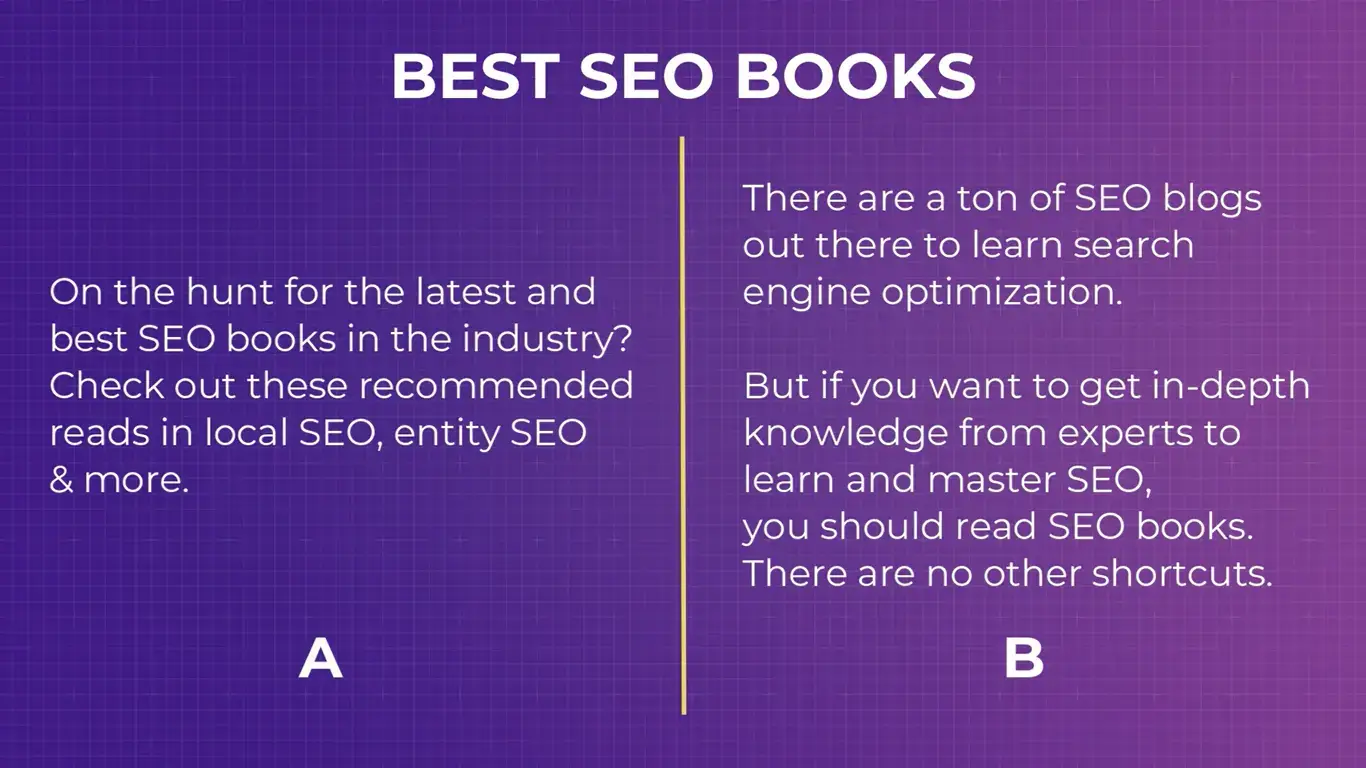
The main topic of these two paragraphs is “Best SEO Books”. Can you tell me which is ranking on the first page of Google? Is it A or B?
Are you ready? If your answer is B, you are absolutely wrong. A Ranks on the first page. Congratulations to everyone who answered A. And here’s your free SEO audit tool.
Go to “rankmath.com/tools/seo‐analyzer“, place your domain here, and you will get a free SEO audit. Oops! Those who answered B get that as well.
Anyway, you are here to learn how to write the best introduction for your blogs or articles. So, let’s analyze why A ranks on the first page instead of B.
How To Write An Introduction Paragraph In 2022?
Good & Bad Introduction Comparison
What is the search intent when somebody searches for “Best SEO Books”, it means, I want to know the best SEO books available out there.

But as simple as that, B is giving you reasons why you should read SEO books, while A is telling you, here’s a bunch of SEO books, go read them.
So, if you were to search for “Best SEO Books” on Google, which article? A or B? Will you read further? For me, it is going to be an A because it answers my search intent immediately without telling me a bunch of stuff that I already know or don’t want to know.
Unless the question is why we should be reading SEO books, then there’s no point. And then B is more appropriate here.
So, in this blog, we’re going to share with you some tips, formulas, and examples on how to write a catchy blog introduction for both humans and search engines.
Hey, it’s Jayan from Digi Skill Grow, and we are all about providing you with the most cutting‐edge SEO tools and knowledge.
Why is a Good Introduction Important?

Now, I’m pretty sure you already know that an introduction paragraph is super important. If you don’t know that yet, here’s a stat for you.
A study from Sumo.com finds that 32% of site visitors left after reading only 140 words as a result of poorly optimized opening paragraphs. Don’t believe the stat? That’s fine.
Just analyze your own reading pattern and you’ll know that while searching for something on Google, you will click on the result that has the most relevant title, and you’ll read the first couple of paragraphs to see if the article understands you.
If it does, you’ll continue scrolling to the article, reading only the headings, and stop to read when something catches your attention.
But if the first few paragraphs seem boring, too lengthy, beat around the bush, don’t give a good impression, and so many other reasons, a typical reader will hit the back button.
Attractive Introduction Formula
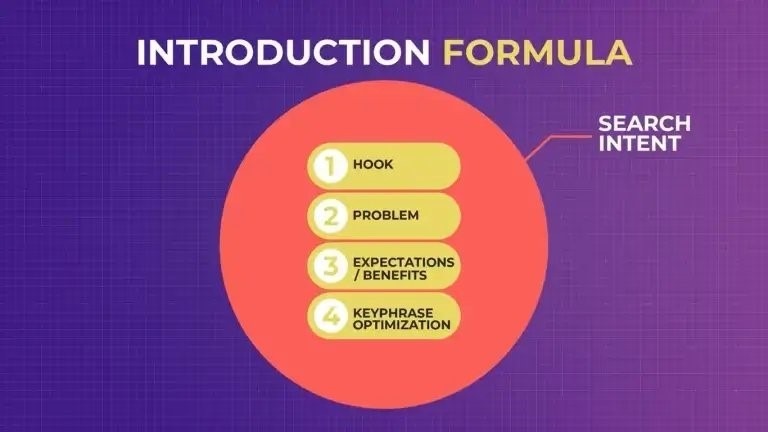
Alright, so what’s the science behind writing a good introduction paragraph? Let’s talk about them now.
- Hook,
- Problem,
- Expectations / Benefits,
- Key phrase optimization,
- And the underlying element is a deep understanding of the “Search Intent”.
Without hitting the nail on the search intent, everything will go wrong. So, now let’s talk about how to identify the search intent, and then I’ll give you some tips and examples on how to craft the best introduction paragraph.
How to Understand Search Intent?
Now, the best way to understand search intents is to do a search on the key phrase. Most search engines are already sophisticated, so they know what the search intent is, and they will tell you by displaying the best matching results at the top.
So, especially if you are a beginner, whenever you are targeting a key phrase and you think you know best, I would advise you to double‐check the search intent before writing your content.
Types of Search Intent

To break it down further, there are four common types of search intent. The “Informational Intent”, typically consists of who, what, how, guide, etc, in the search phrase.
For example, “how to bake a cake”, “what is link building” or “SEO guide for beginners” People who search for these types of key phrases are looking for information or knowledge.
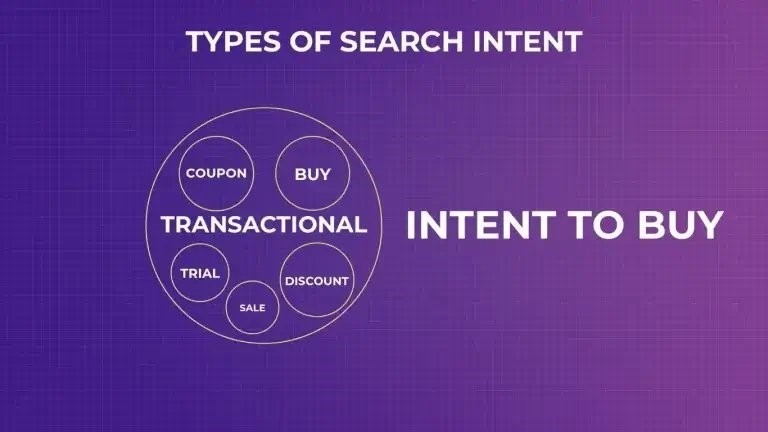
Then we have the “Transactional intent”, which typically consists of buy, discount, coupon, trial, sale, etc. Ecommerce stores love to target these key phrases related to their brand or products because they know people have the intent to buy their products.
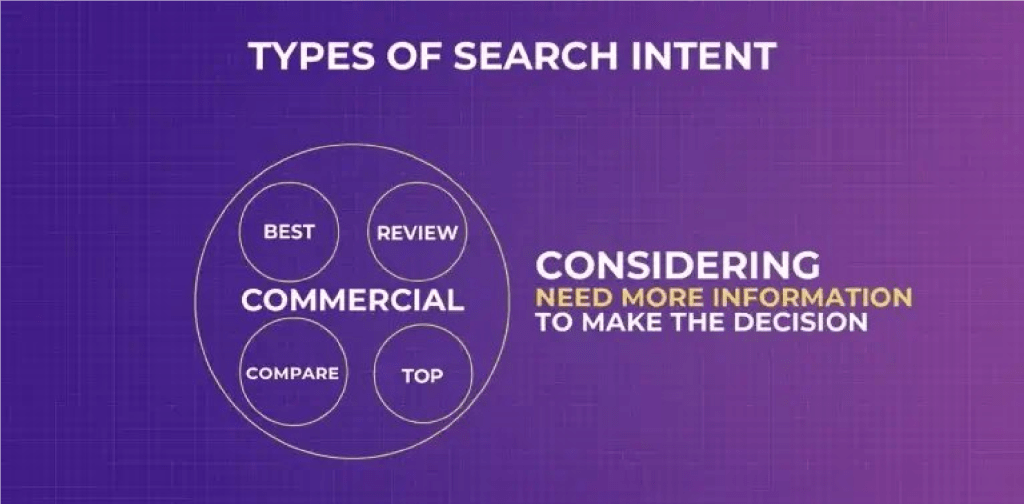
Next, we have the “Commercial Intent”, which affiliate marketers love such as review, top, best, comparison, etc. People who are searching for these key phrases are considering if they should buy the product. They just need more information to make the decision.

And finally, the “Navigational Intent”, which typically consists of login, brand name, terms, conditions, etc. People who search for such key phrases already know what they are looking for and they just need the search engines to direct them.
So, with a clear understanding of the search intent, we can now talk about the formula for writing an awesome introduction paragraph.
How to Create an Intro Hook
Fundamentally, the introduction is the bridge between the topic header and the rest of the content. So, if the hook of the introduction, or simply put, the first sentence of your article, is not strong enough.
The readers will not cross the bridge to read or scroll through the rest of the content. Truth hurts, I know. We spend hours and days writing the content and people just won’t read it.
Types of Introduction Hooks
Now, there are a few ways to have an adequate hook for your introduction.
1. Intriguing Fact or Statistics
Number one is to include an “Intriguing Fact or Statistics” related to the topic. For example, in our article about optimizing podcasts for SEO, we give an interesting stat at the start that relates to the topic.
2. Rhetorical Question
Number two is “Ask a Rhetorical Question” related to the topic. Remember, at the start of this blog, I asked you a question and now you’re still here, which means my hook works.
In terms of written content, we ask a rhetorical question to create a dramatic effect in this article.
3. Triggering or Controversial opinion


For example, in this article, about 40 unique things you can do with Rank Math SEO. We started with this triggering question.
4. Relate to a Problem
Number four “Relate with a Problem”. This is a hook we use very often on our blog because most of our content is “how‐to” content. And people often search for these contents when they have a problem.
So, the best way to connect with them is to describe the problem. For example, “Could you please tell me if there’s any kind of error message in WordPress telling you that the page you’re trying to access has been removed?
For example, “Can you please tell me if there is an error in WordPress telling me that the link you just tried to click on has been removed? Or “Have you ever wondered how to change the name of the product page in WooCommerce?”
These are the four best hooks I’ve seen for most of the search intent. Of course, there are other hooks, but I assure you that these hooks can work on almost any search phrase.
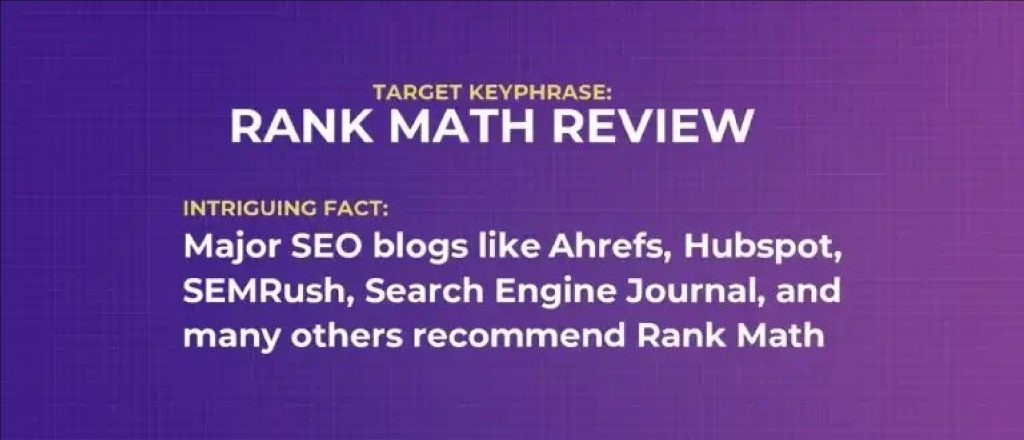
For example, if our target keyword is “Rank Math Review” the intriguing fact hook will be “Major SEO blogs like Ahrefs, HubSpot, SEMRush, Search Engine Journal, and many others recommend Rank Math“.
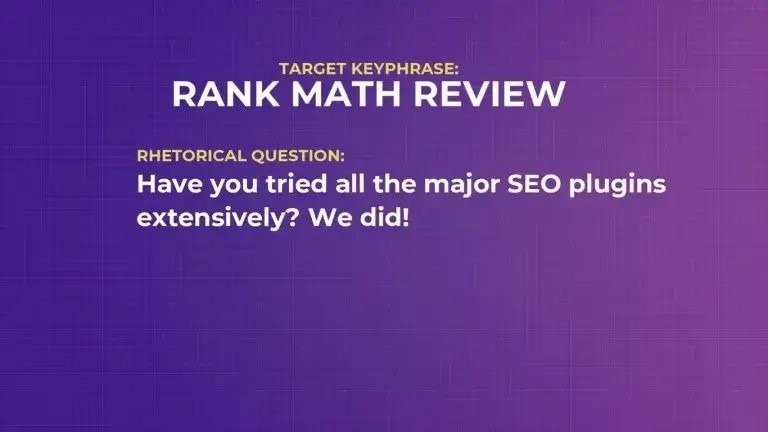
The rhetorical question will be, “Have you tried all Major SEO plugins extensively? We did!’’
The triggering opinion will be “Rank Math is the best SEO plugin I’ve used so far!’’
Relate with a problem will be “Need a better SEO plugin without breaking the bank?’’
Do you see how it works? Now let’s go to the next element of the formula which is
“Introduce the Problem”
Introduce The Problem
After you’ve tossed out the hook, you’ve got to reel it in with the problem. There must be some problems people are facing, otherwise, there is no reason for them to read further unless it is news.
So, understanding the search intent is super helpful in writing this part of the introduction. You can use two to three sentences to introduce the main problem you are solving in the blog post.
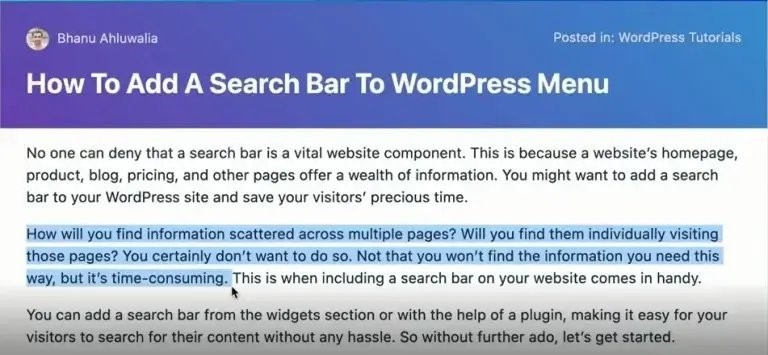
Let’s see how we do it in one of our posts. This article shares how to add a search bar to the WordPress menu. After the hook, which states a fact, we start to introduce the problem at hand.

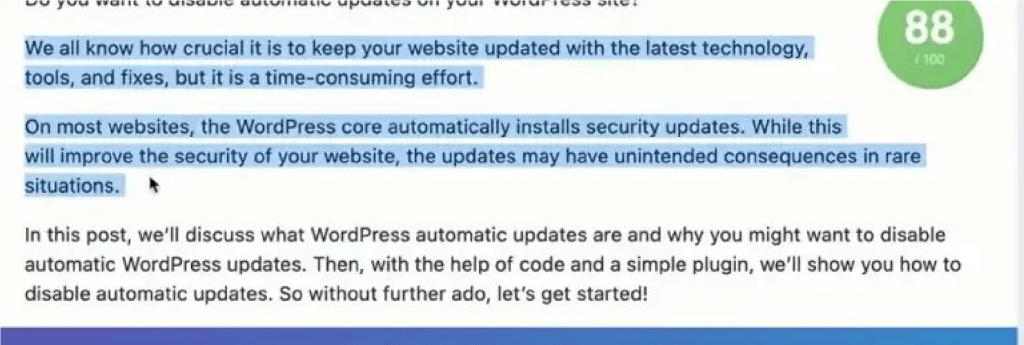
How about this article that teaches people how to disable automatic updates in WordPress? We started with a problem relation hook, and then we moved on to the problem.
You get the idea. We have the hook, and then we state the problem as creatively as possible, and then the next element to the formula is “Expectations”.
Inform Readers What to Expect
Writer: I mean, if there is no outcome or solution to the problem I’ve just painted, then what’s the point of writing the article? Right? The article is long. There’s a solution for you in there.
Reader: But I want to know if you have the solution.
Writer: It’s in there. Read it.
Reader: What should I expect? What are the benefits of reading? Tell me.
Writer: Read it! Reader: Bye!
Yeah. So, inform your readers what they can expect from your article and what they are going to get out of it. The Benefits.
Nowadays, people are just too busy with the noise that they don’t want to bother about reading if it is not worth their time. If you visit any one of our blog posts, you will always see that we have a paragraph to inform readers what to expect and what they can benefit from it.
So, we have the hook, the problem, the expectations, and the benefits. Now we’re going to add one last piece to our formula: optimizing your intro for SEO.
Optimize Introduction For SEO
What we have done in the previous elements is to capture the attention of human readers, and us. Now, you need to optimize it so that search engines will understand your content much easier.
Yes, search engines like Google are getting pretty amazing at understanding human language. But it is still helpful to them if you make it easier for them to understand.
Best SEO Practice for Introduction
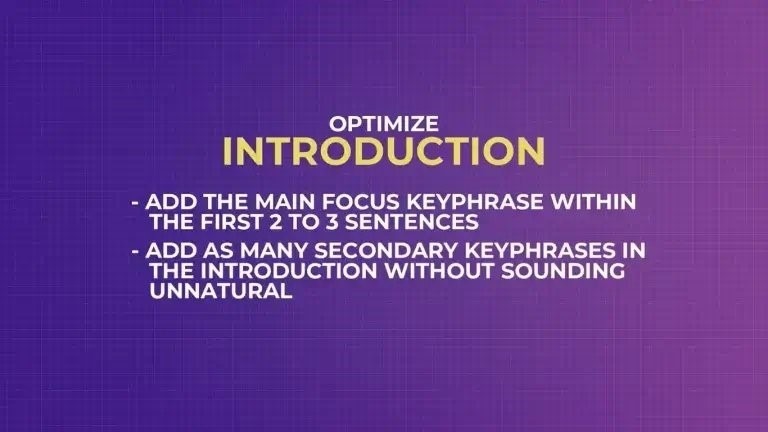
So, the best practice for SEO optimization is to put the main focus key phrase within the first two to three sentences. And then you want to put as many secondary keywords as possible in the introduction without sounding unnatural.
Meaning you should not be forcing keywords into it. But the problem is, how do you know what secondary keywords you should add?
Use Content AI to Assist with SEO
Well, use content AI! If you’re using rank math, this tool comes in tandem with it. Place your main focus key phrase and hit Research and it will give you smart suggestions that include keywords you should add to your content.
Try to add as many of these keywords as possible to your introduction naturally. Let’s see how I include these keywords in the introduction.
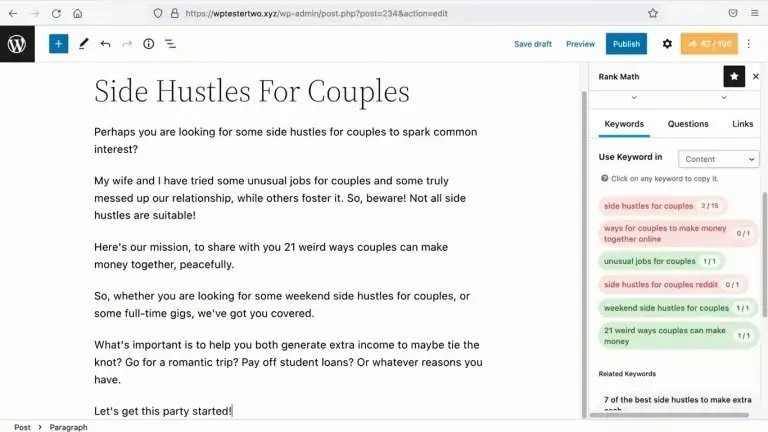
You may want to pause this reading to see how I add these keywords into the introduction without sounding unnatural.
You see, I’ve added the main keyphrase in the first sentence and I’ve added three other secondary keywords. I hope you see how Content AI is useful to you. It will even suggest keywords to add to your headings.
Conclusion: Special Tip for Existing Sites.
So, there you have it. I share some of the best ways how to write an introduction paragraph. Once you have a deep understanding of the search intent, you can apply the formula or sequence to your introduction to make it sexy, make it cool, make it enticing for people to read.
If you find this blog helpful, can you do us a little favor and smash that share button? And since you are still here, I want to give you an important tip.
This is especially helpful for sites that have been around for a couple of years. If you have been using the Rank Math analytics module, what you want to do is to visit the “SEO Performance” tab and figure out the contents that are not performing well.
You want to single them out by the number of clicks and impressions. There is a high chance that these articles are not satisfying the search intent well enough. So, click into the entry and now you will see what keywords your article is ranking for.
That way you can try to understand the search intent of those keywords and apply the introduction formula, update the content to match the search intent, and see how the rankings of your article improve.



